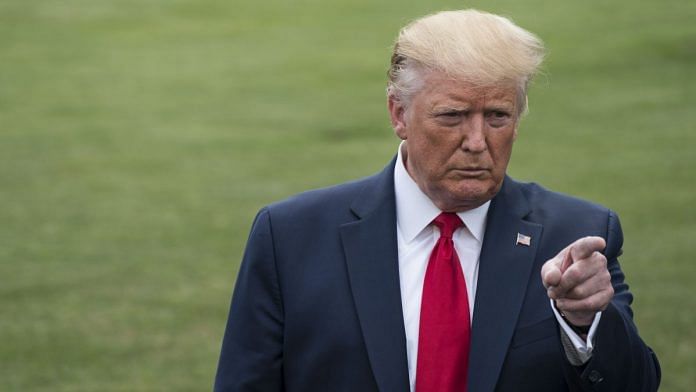New Delhi: The New York Times (NYT) has come under fire for publishing specific details about the whistleblower who had filed a complaint against US President Donald Trump, alleging that he asked for Ukrainian President Volodymyr Zelensky’s help to smear Joe Biden who is the Democratic Party front-runner in the 2020 elections.
In its report, NYT had specifically identified the whistleblower as a Central Intelligence Agency (CIA) analyst, who was closely connected to the White House and also mentioned the fact that he had specific knowledge about Ukraine.
“His complaint suggested he was an analyst by training and made clear he was steeped in details of American foreign policy toward Europe, demonstrating a sophisticated understanding of Ukrainian politics and at least some knowledge of the law,” the report stated.
Dean Baquet, NYT Executive Editor, issued a clarification later, defending its decision to reveal details about the whistleblower.
“We decided to publish limited information about the whistleblower — including the fact that he works for a non-political agency and that his complaint is based on an intimate knowledge and understanding of the White House — because we wanted to provide information to readers that allows them to make their own judgments about whether or not he is credible,” he said.
Mark Zaid, the whistleblower’s attorney, tweeted, “Publishing details about whistleblower will only lead to identification of someone, whether our client or wrong person, as whistleblower. This will place individual in much more dangerous situation, not only in their professional world but also their possible personal safety.”
The complaint
The House intelligence committee released the whistleblower’s complaint Thursday and House Speaker Nancy Pelosi was compelled to begin impeachment proceedings against President Trump, as a consequence. This is the fourth time in US history that impeachment proceeding against a sitting President has been issued.
According to the whistleblower’s complaint, Trump called Zelenskiy to “solicit interference” in the upcoming 2020 elections. The complaint also suggested that the White House attempted to lock down the transcript of the call, suggesting a possible cover-up.
Also read: This is what it will take to impeach Donald Trump over call to Ukrainian President Zelensky
Trump vs NYT
Trump and NYT share a tumultuous history with the US President calling out the newspaper several times for allegedly misquoting him and publishing fake news.
According to the newspaper’s own admission, Trump has insulted the NYT 218 times until May this year.
He has previously called NYT reports, “fake news”, “phony news”, and even went on to say that it “lie and cheat anyway possible to make me look bad”. He has also accused the newspaper of being corrupt and dishonest.
In the whistleblower’s case also, Trump attempted to brush off the complaint as fake news and a witch-hunt.
This is also probably the reason why the NYT deemed it appropriate to release the whistleblower’s details.
Baquet’s statement mentions these comments made by Trump. “The President and some of his supporters have attacked the credibility of the whistleblower, who has presented information that has touched off a landmark impeachment proceeding. The President himself has called the whistleblower’s account a ‘political hack job’”, he said in a statement.
NYT gaffes
Since January, NYT has been regularly embroiled in controversies. Last month, the newspaper had given a headline on one of Trump’s speeches as ‘Trump urges Unity vs. Racism’. NYT received a lot of flak for not properly contextualising his comments and later changed the headline to ‘Assailing Hate but Not Guns’.
The headline led to a lot of controversy and propelled conversation about how it covered race.
Jonathan Weisman, a deputy Washington editor of The Times, was also demoted “because he repeatedly posted messages on social media about race and politics that showed what the paper called ‘serious lapses in judgment’”.
More recently, the NYT released fresh allegations of sexual harassment against Supreme Court Justice Brett Kavanaugh, which also drew controversy. The allegations were part of a book excerpt by NYT reporters and were carried in the Sunday Review section and not the news section.
It issued a clarification, saying the book was “well-reported” and is a “newsworthy account” that “sheds light in matters of national importance”.
“The excerpt of the book was published in the Sunday Review, a section that includes both news analysis and opinion pieces. The section frequently runs excerpts of books produced by Times reporters,” it added.
There were also concerns regarding the fact that the newspaper withheld such sensitive information until the book was published.
Also read: Impeaching President Trump could be perilous for US democracy
On past whistleblowers
It is not a conventional practice for a newspaper to reveal a whistleblower’s identity. Edward Snowden released ‘Top Secret’ National Security Advisory files anonymously but The Guardian released his identity later — only after his consent.
The identity of Chelsea Manning, former intelligence analyst to the US military who released 7,50,000 classified documents to Wikileaks, was revealed after she was arrested on charges of espionage by the military.
The United States Constitution also protects intelligence committee whistleblowers from retribution through the Intelligence Community Whistleblowers Act of 1998.
The Act allows a whistleblower to file his complaint through internal channels. The complaint can also be sent to the director of CIA if action is not taken by lower-ranked officers.
Also read: Ukraine scandal shows that Donald Trump is his own enemy







Outing a CIA operative is a criminal offence. However, this is not a normal case. That gentleman, a true patriot, has, in a sense, outed the President. The loss of some aspects of his utility to the organisation is a price worth paying for the US to observe him testify before the appropriate Committees, to judge whether the occupant of the Oval Office has forfeited the right to continue.